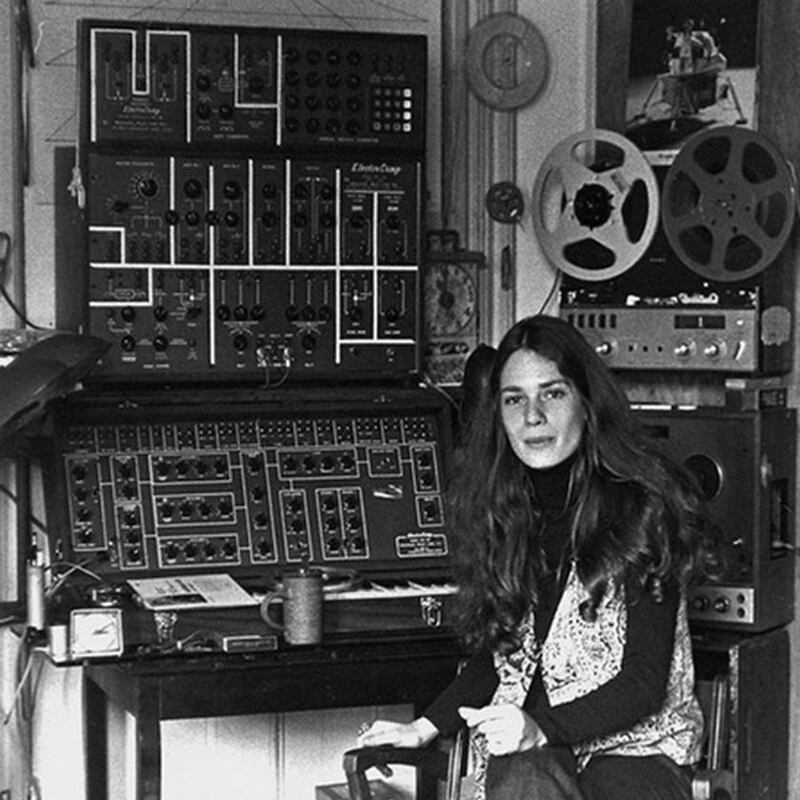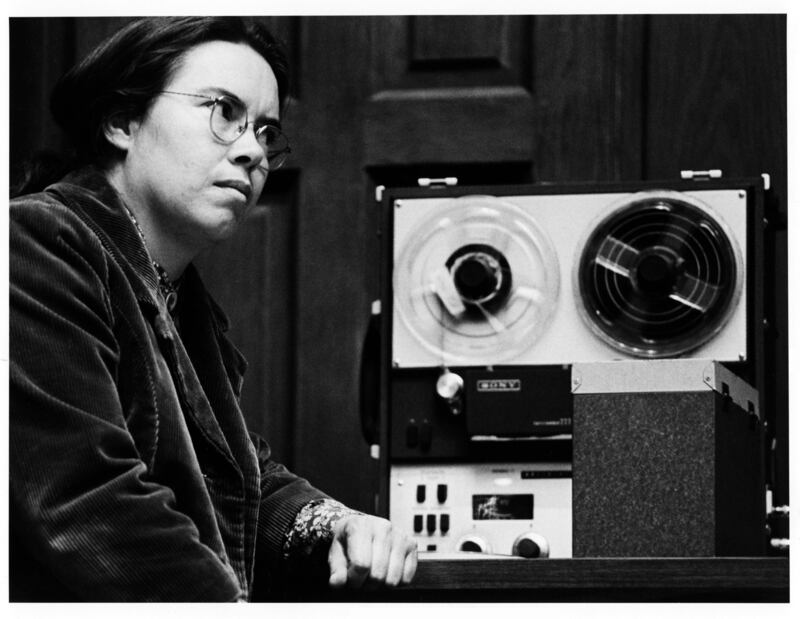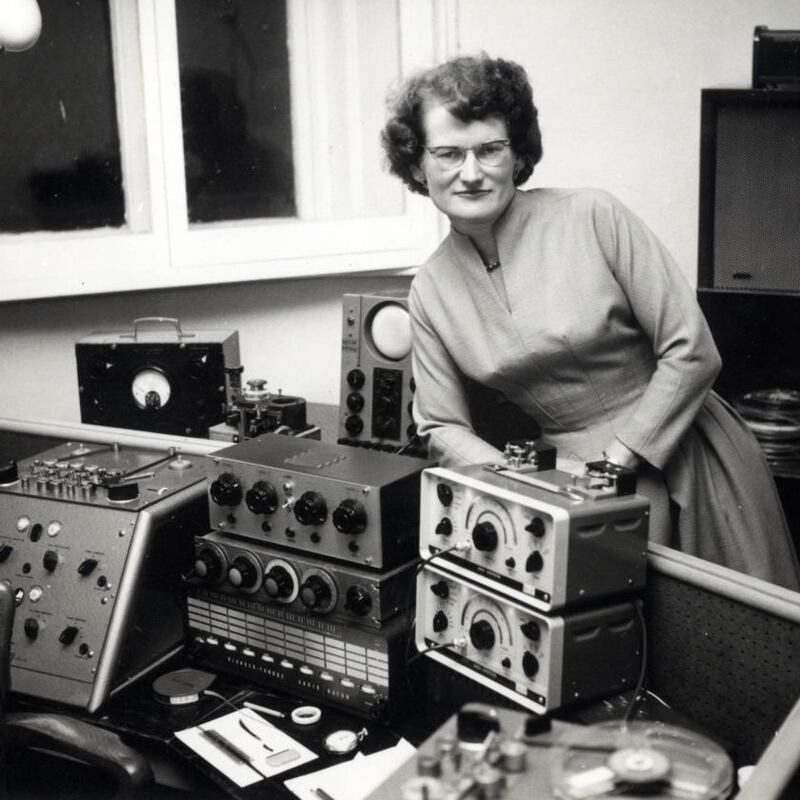"This is a story of women who hear music in their heads, of radical sounds, where there was once silence.” The narrator of an excellent new documentary on female pioneers of electronic music and electronic sounds, who happens to be Laurie Anderson, begins the film with a pronouncement around the idea of genesis. Every idea comes from silence, and every sound comes after it. In Sisters With Transistors, the silence that has actually acted as a form of erasure and suppression of female participation, invention, innovation, and in many cases, genius, at the vanguard of creating new electronic sounds, begins to break.
As the composer Laurie Spiegel says in the film, “women were naturally drawn to electronic music, you didn’t need to be accepted by the male-dominated resources . . . somehow women get forgotten from the history.” Sisters With Transistors is so loaded with magical almost mythical sounds that break through literal silence, but also that cut through the silencing caused by omission from history with “beautiful noise” as the film puts it. This truly modern music was formed with different building blocks, and an entire new architecture of sound was created.
The director, Lisa Rovner, once stumbled upon a timeline of female pioneers and became fascinated by them. Electronic music was the soundtrack to her own personal liberation, “I became my own person when I danced in clubs,” she says. She had heard of many of the artists, but didn’t realise there were so many, “I think what really drew me to them,” she says, “was originally the photographs of people whose music I didn’t know, but also that they were truly independent, persistent artists, falling in love with a medium.”
Rovner grew up in Washington DC where there was a vibrant underground rave scene, and then moved to Montreal which had a huge rave scene, and then on to France where she soaked up the French touch movement in house music. She studied political science in Canada, and since her early 20s was thinking deeply about politics and storytelling, and the consequences of storytelling. For the film’s form, she wanted to avoid “the way we tell stories in this reductive way,” and “break free from the traditional way of telling the story, the myth of the sole genius. I wanted to tell the story that drew connections, rather than singled out individuals. Because these women are so idiosyncratic, it was important to me to give them the space to explore how individual the creation was.”
Rovner insists that this is not a definitive history, not “the” history, but “a” history, and an entry point. She had initially hoped to secure funding from a television broadcaster, but that didn’t happen, something she says was a blessing in disguise, “It was obviously way more difficult to make the film without that, but it allowed us to make the film we wanted to make, rather than fall into these traps.” The traps, she says, are the traditional documentary structures that often create gaps in history through telling stories in a particular way. “There is a loneliness to the film that resonates. But there is a beauty in that. There is a beauty in stillness, being quiet.”

One extraordinary sequence is footage of Clara Rockmore playing the theremin with not just virtuosity, but with an incredibly moving tenderness. Rockmore, a Lithuanian violin prodigy who emigrated to the US following the Bolshevik Revolution, met another Russian immigrant, Leon Theremin, whose instrument Rockmore mastered.
A woman who looms large in this history is, of course, Delia Derbyshire, the electronic music composer whose influence continues today. Here, her work is contextualised as almost darker than the spooky, creepy otherworldliness many are already familiar with, typified by her extraordinary composition of the Doctor Who theme music. Accepted by Oxford and Cambridge to read maths, already remarkable for a working-class female teenager in the 1950s, she speaks about how the sounds she went on to imagine and produce, were moulded by the second World War, from her memories of the bomb sirens in Coventry during the blitz.
Nikola Tesla: 'Women will some day unleash their enormous creative potential and for a time will excel men in all fields...'
Daphne Oram is also here, a gifted pianist who turned down a place at the prestigious conservatory to lean into her love of technology and, like Derbyshire, who went to work for the BBC. Oram invented Oramics, a method of painting shapes on to 35mm film which were then converted into sound.
There’s Éliane Radigue, inspired by the sound of airplanes, and who gravitated towards the ARP synthesiser. There’s Maryanne Amacher who was at MIT and explored incredibly complex psychoacoustic phenomena, and whom John Cage invited to collaborate, and who also worked with his partner, the groundbreaking choreographer, Merce Cunningham.

There’s Pauline Oliveros, who was a founding member of the San Francisco Tape Music Centre, and whose 1970 op-ed for the New York Times “And don’t call them ‘Lady Composers’” – is well-worth revisiting: “Near the beginning of this century, Nikola Tesla, electrical engineer and inventor of AC power,” she wrote, “predicted that women will some day unleash their enormous creative potential and for a time will excel men in all fields because they have been so long dormant. Certainly the greatest problems of society will never be solved until an equalitarian atmosphere utilising the total creative energies exists among all men and women.”
'...I went through a period of emotional, romantic exploration. Now I am exploring freedom once again'
Suzanne Ciani’s early work using the Buchla synthesiser is fascinating to watch evolve on film. Ciani is a master of sound. Moving through music and advertising (she created, among many things, the iconic sound of a bottle of Coca Cola being opened and almost musically pouring into a glass for its television ads in the 1970s), her presence in the documentary feels truly liberating, her enthusiasm and confidence contagious. She answered some questions over email for this article. “It feels ‘about time’,” she says, of her work being contextualised within the film, “Having felt isolated and non-contextualised for most of my life, it is wonderful to be surrounded by my sister explorers, some of whom I have discovered only recently and through this film.”

A misconception she feels around such pioneers of music made by machines and electronic equipment is “that it was technical. Yes, there is a tech side, and there might be lots of wires and knobs and dials, but what we were trying to say with those machines is what is important. We played with them, we romanced them, we loved them.”
The film, which will screen on IFI@HOME, contains a particular weight that somehow lands with even more profundity in the context of the pandemic, where clubs are closed and the desire for release and the spirituality of the collective experience that listening to electronic music provides is not accessible. Yet here we can see the quietness and the loudness of creativity and craft. Almost bizarrely absent from the artists covered in the film is any sense of ego. Instead, there’s an enthusiasm and a thrill, a nerdy pride as they present their latest inventions through television interviews at the time. They are frequently framed in the archive footage itself as curiosities, outliers, and it’s a rare insight into women working in highly technical, intensely creative ways in the mid-20th century. Collected together, despite the fact that the documentary is essentially one of brilliantly collaged archive footage, there is something incredibly exciting and “present day” about it all. Perhaps that’s the power of discovering what an artist was doing decades ago that really speaks to you. It can feel as though what they’re doing is happening now, because the impact and emotional reaction is so contemporary.

As a child, the sounds that gave Ciani the most pleasure, she says, were the water when she removed her bathing cap, the sound of the Tennessee Waltz record her mother played, the sound of the Steinway piano as she played Chopin, the sound of a tennis ball being hit, the sound of the wind and the waves. “At first I was exploring freedom, independence, newness, exploration itself,” she says of her early work, “Then I went through a period of emotional, romantic exploration. Now I am exploring freedom once again.”
If the pandemic was a sound, according to Ciani, what would it be? “Silence.”
Sisters With Transistors, presented by IFI, aemi and Dublin Feminist Film Festival & IFI, screens on IFI@HOME from March 5th to March 9th. ifihome.ie













